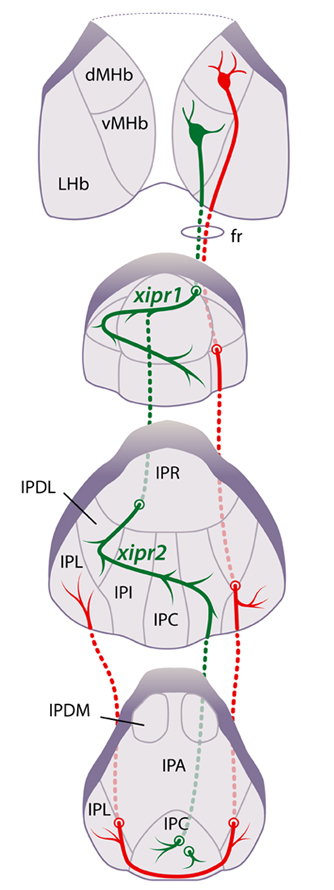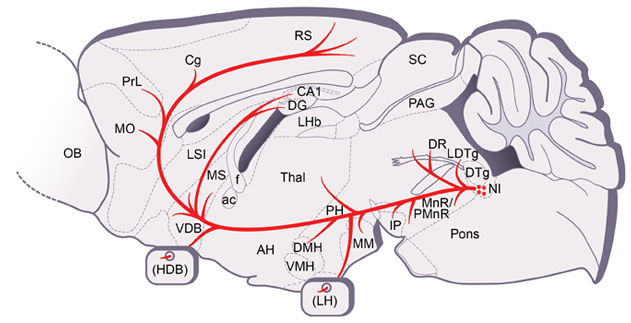Turner Lab
Welcome to the Turner Lab
The Turner Lab is defining neural pathways underlying motivation, emotion and addiction, using genetic and optogenetic strategies to map brain circuits in mice. Our research areas include:
Function of the medial habenula-interpeduncular nucleus circuit

(Credit: Benedicte Rossi)
The habenula is a poorly understood region of the brainstem residing just dorsal to the thalamus, with distinct medial and lateral subnuclei. Essentially the entire output of the medial habenula (MHb) is directed to the interpeduncular nucleus in the midbrain tegmentum. Neurons in the ventral MHb produce acetylcholine, but use glutamate as their primary fast neurotransmitter. The function of this circuit, and its modulation by nicotine and nicotinic receptors, is an area of active research in our lab (Hsu, et al 2013: Quina et al. 2016). Neurons in the dorsal MHb are distinguished by the expression of neuropeptides such as substance P, and form a distinct circuit. In Hsu et al, 2014, we demonstrated that this circuit is required for the rewarding effects of wheel running exercise, and that optogenetic stimulation of this area is intrinsically reinforcing; we postulate that the dorsal MHb has an important role in mood regulation.
Related publications
- Hsu Y-W, Tempest L, Quina LA, Wei AD, Zeng H, and Turner EE. A medial habenula output circuit mediated by 5 nicotinic receptor-expressing GABAergic neurons in the interpeduncular nucleus. J. Neuroscience 2013; 33:18022-35. PMCID: PMC3828458.
- Hsu Y-W, Wang SD, Wang S, Morton G, Zariwala H, de la Iglesia HO, and Turner EE. Role of the dorsal medial habenula in the regulation of voluntary activity, motor function, hedonic state, and primary reinforcement. J. Neuroscience 2014; 34:11366-11384. PMCID: PMC4138345.
- Hsu Y-W, Morton G, Guy, EG, Wang SD, and Turner EE. Dorsal medial habenula regulation of mood-related behaviors and primary reinforcement by tachykinin-expressing habenula neurons. eNeuro 2016; 3. PMCID: PMC4947983.
- Quina LA, Harris J, Zeng H and Turner EE. Specific connections of the interpeduncular subnuclei reveal distinct components of the habenulopeduncular pathway. J. Comp. Neurology 2017, in press.
- Hsu Y-W, Gile JJ, Perez JG, Morton G, Ben-Hamo M, Turner EE and de la Iglesia HO. Role of the dorsal medial habenula in the regulation of circadian rhythms and sleep. Journal of Biological Rhythms 2017, in submission.
Structure and function of the lateral habenula system
Recently we have begun studies of the lateral habenula (LHb), which forms a system functionally distinct from the MHb. There has been a great deal of recent interest in the role of LHb outputs to the dopamine system in reward prediction error. However, our anatomical studies indicate that the majority of LHb outputs go to areas of the brain associated with serotonin signaling. Our functional studies of the LHb will focus on these pathways.
Related publications
- Quina LA, Tempest L, Ng L, Harris J, Jhou T, and Turner EE. Efferent pathways of the mouse lateral habenula. J. Comp. Neurology 2015, 523:32-60. PMC4232452.
Function of the ascending Relaxin3 system of the nucleus incertus

(Credit: Benedicte Rossi)
The nucleus incertus is another brainstem nucleus of poorly understood function, characterized by the expression of an insulin-family peptide, relaxin3. This system receives descending input from the habenula and interpeduncular nucleus, then projects widely to the limbic system, in a pattern resembling the dopamine and serotonin systems. In a new area of research for the lab, we are designing genetic approaches to the function of this system in transgenic mice.
Development of combinatorial genetic models for behavior and circuit mapping
In order to provide a new set of tools for high-resolution optogenetic studies of brain function, we collaborated with the Allen Institute to characterize a set of Cre recombinase-inducible optogenetic mice that allow the expression of a Channelrhodopsin activator or a Halorhodopsin silencer in any neural population that can be defined by a Cre-driver mouse line, of which there are many. Now that these mice have been distributed to the neuroscience community through the Jackson Laboratories, their use is expanding rapidly.
Related publications
- Madisen L, Mao T, Koch H, Zhuo J-M, Berenyi A, Fujisawa S, Hsu Y-W, Garcia A, Gu X, Zanella S, Kidney J, Gu H, Mao Y, Hooks BM, Boyden ES, Buzsaki G, Ramirez JM, Jones AR, Svoboda K, Han H, Turner EE, Zeng H. A toolbox of Cre-dependent optogenetic transgenic mice for light-induced activation and silencing of targeted neural activity. Nature Neuroscience 2012; 15:793-802. PMCID: PMC3337962.
Other Areas of Investigation
See other recent studies in the Turner Lab: Transcriptional regulation of neuronal development and morphogenesis of the external ear.
Publications
See a complete list of published work on the National Center for Biotechnology Information website.
Investigator Biography
 Eric E. Turner, MD, PhD, is a principal investigator at Seattle Children’s Research Institute’s Norcliffe Foundation Center for Integrative Brain Research and a professor in the Department of Psychiatry and Behavioral Sciences at the University of Washington.
Eric E. Turner, MD, PhD, is a principal investigator at Seattle Children’s Research Institute’s Norcliffe Foundation Center for Integrative Brain Research and a professor in the Department of Psychiatry and Behavioral Sciences at the University of Washington.
